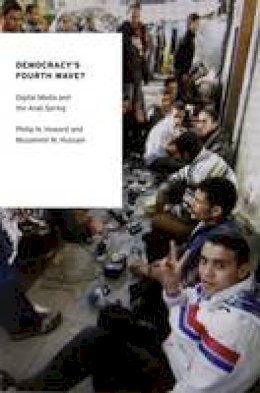
Stock image for illustration purposes only - book cover, edition or condition may vary.
Democracy´s Fourth Wave?: Digital Media and the Arab Spring
Philip N. Howard
€ 49.08
FREE Delivery in Ireland
Description for Democracy´s Fourth Wave?: Digital Media and the Arab Spring
Paperback. Series: Oxford Studies in Digital Politics. Num Pages: 160 pages, 8 tables, 2 photographs, 5 graphs. BIC Classification: 1FB; 1HB; 3JMG; HBLX; HBTV; UBJ. Category: (G) General (US: Trade). Dimension: 235 x 156 x 10. Weight in Grams: 272.
In 2011, the international community watched as a shockingly unlikely community of citizens toppled three of the world's most entrenched dictators: Ben Ali in Tunisia, Mubarak in Egypt, and Qaddafi in Libya. This movement of cascading democratization, commonly known as the Arab Spring, was planned and executed not by political parties, but by students, young entrepreneurs, and the rising urban middle class. International experts and the popular press have pointed to the near-identical reliance on digital media in all three movements, arguing that these authoritarian regimes were in essence defeated by the Internet. Is that true? Should Mubarak blame Twitter for his sudden fall from power? Did digital media cause the Arab Spring? In Democracy's Fourth Wave?, Philip N. Howard and Muzammil M. Hussain examine the complex role of the Internet, mobile phones, and social networking applications in the Arab Spring. Examining digital media access, level of grievance, and levels of protest for popular democratization in 16 countries in the Middle East and North Africa, Howard and Hussain conclude that digital media was neither the most nor the least important cause of the Arab Spring. Instead, they illustrate a complex web of conjoined causal factors for social mobilization. The Arab revolts cascaded across countries largely because digital media allowed communities to realize shared grievances and nurtured transportable strategies for mobilizing against dictators. Individuals were inspired to protest for personal reasons, but through social media they acted collectively. Democracy's Fourth Wave examines not only the unexpected evolution of events during the Arab Spring, but the longer history of desperate-and creative-digital activism through the Arab world.
Product Details
Publisher
Oxford University Press Inc United States
Number of pages
176
Format
Paperback
Publication date
2013
Series
Oxford Studies in Digital Politics
Condition
New
Number of Pages
160
Place of Publication
New York, United States
ISBN
9780199936977
SKU
V9780199936977
Shipping Time
Usually ships in 4 to 8 working days
Ref
99-1
About Philip N. Howard
Philip N. Howard is Associate Professor in the Department of Communication at the University of Washington, with adjunct appointments at the Jackson School of International Studies and the Information School. Muzammil M. Hussain is a Ph.D. candidate in Communication at the University of Washington and Visiting Scientist at the Center for Comparative and International Studies, ETH Zurich.
Reviews for Democracy´s Fourth Wave?: Digital Media and the Arab Spring
Philip N. Howard and Muzammil M. Hussain's study implies that... digital media played a much longer term role in creating favorable conditions for uprisings, helped to publicize key igniting events, and then facilitated those uprisings and their diffusion; but digital media did not do this alone or as suddenly as some observers have claimed... There are a number of other unique contributions, but there is insufficient space to review them all. Overall, I predict that future research will look kindly to the authors' key findings, particularly the book's central claim that digital media were one essential ingredient in larger casual recipes for revolution and democratization.
Political Science Quarterly
This book represents the first serious effort to transcend the polarized debate between cyber-utopians and tech-skeptics regarding digital media's role in the 2011 Arab Uprisings. Carefully argued and documented, it is of landmark importance and should be required reading for all those who seek to understand the interface of technology and political change and the future of democratization.
Peter Mandaville, George Mason University, author of Global Political Islam
This unprecedented multidisciplinary approach to the examination of the Arab Spring situates itself in digital revolutions and political transformations. I highly recommend it for students, activists, and policy makers seeking to understand how modern communication technologies are driving the Fourth Wave of Democracy in the Arab world.
Imad Salamey, Associate Professor of Political Science, Lebanese American University
Democracy's Fourth Wave? guides readers through the avalanche of factors that meshed with digital media to produce the Arab Spring. The authors subtly adapt traditional methodologies to decode mysteries of complex causal effects. In doing so, their book brings clarity and insight to the conundrums of new technologies as factors in regime fragility and protest success.
Monroe E. Price, Annenberg School for Communication, University of Pennsylvania
Political Science Quarterly
This book represents the first serious effort to transcend the polarized debate between cyber-utopians and tech-skeptics regarding digital media's role in the 2011 Arab Uprisings. Carefully argued and documented, it is of landmark importance and should be required reading for all those who seek to understand the interface of technology and political change and the future of democratization.
Peter Mandaville, George Mason University, author of Global Political Islam
This unprecedented multidisciplinary approach to the examination of the Arab Spring situates itself in digital revolutions and political transformations. I highly recommend it for students, activists, and policy makers seeking to understand how modern communication technologies are driving the Fourth Wave of Democracy in the Arab world.
Imad Salamey, Associate Professor of Political Science, Lebanese American University
Democracy's Fourth Wave? guides readers through the avalanche of factors that meshed with digital media to produce the Arab Spring. The authors subtly adapt traditional methodologies to decode mysteries of complex causal effects. In doing so, their book brings clarity and insight to the conundrums of new technologies as factors in regime fragility and protest success.
Monroe E. Price, Annenberg School for Communication, University of Pennsylvania
